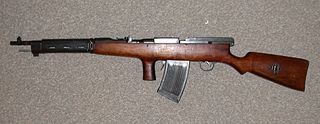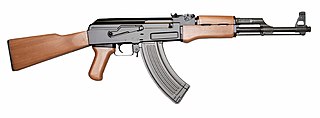
The AK-74 is an assault rifle developed in the early 1970s by Russian designer Mikhail Kalashnikov as the replacement for the earlier AKM. It uses a smaller 5.45×39mm cartridge, replacing the 7.62×39mm chambering of earlier Kalashnikov-pattern weapons.

The Fedorov Avtomat or FA was a select-fire, handheld light-machine-gun, designed by Vladimir Grigoryevich Fyodorov in 1915 and produced in the Russian Empire and later in the Russian Soviet Federative Socialist Republic. A total of 3,200 Fedorov rifles were manufactured between 1915 and 1924 in the city of Kovrov; the vast majority of them were made after 1920. The weapon saw combat in World War I, but was used more substantially in the Russian Civil War and in the Winter War.

The AEK-971 is a Russian selective fire 5.45×39mm assault rifle that was developed at the Kovrov Mechanical Plant (KMZ) by chief designer Sergey Koksharov in the late 1970s and 1980s.
A service rifle or service weapon is a weapon which an armed force issues as standard to its service members. In modern forces, this is typically a versatile and rugged assault rifle, battle rifle or carbine suitable for use in nearly all environments. Most armies also have service pistols or side arms.

The OTs-14 Groza is a Russian selective fire bullpup assault rifle chambered for the 7.62×39 round and the 9×39mm subsonic round. It was developed in the 1990s at the TsKIB SOO in Tula, Russia. The weapon is colloquially known as OC-14 or OTs-14 "Groza". The OTs-14-4A "Groza-4" has one derivative, the TKB-0239 (ТКБ-0239), also known as OTs-14-1A "Groza-1", chambered for the 7.62×39mm round.

The A-91 is a bullpup assault rifle developed during the 1990s by KBP Instrument Design Bureau in Tula, Russia as an offspring of the 9A-91 firearm family. While the A-91 retains the basic gas-operated, rotating bolt action and a trigger unit design from 9A-91, it features a bullpup polymer housing, with an integral 40 mm single-shot grenade launcher mounted under the barrel. The earliest prototypes of the A-91 bullpup were fitted with the grenade launcher above the barrel, and with a front vertical foregrip; current models are fitted with the underbarrel launcher, which also serves as a forearm. The A-91 features a forward ejection system, initially developed in Tula by designers like Afanasiev during the early 1960s. In this system, the ejection port is located above the pistol grip, and points forward. Extracted cases are fed from bolt head through the short ejection tube to the ejection port, and fall out of the gun well clear of the shooter's face, even when firing from the left shoulder. As for now, the A-91 is made in small number and, probably, is used by some elite law enforcement units in Russia; it is also offered for export and domestic military and police sales.

The ASM-DT is a Russian folding-stock underwater firearm. It emerged in the 1990s.
The TKB-517 is an assault rifle designed by German Aleksandrovich Korobov. This rifle was externally similar to the AK-47, but based on the lever-delayed blowback mechanism invented by John Pedersen and refined by Pál Király. It turned out to be more reliable and accurate, and easier to produce and maintain. Like the AK series, it was also manufactured with folding stocks, longer, heavier barrels with bipods and even a belt-fed variant. Its rejection was because of a greater proficiency with the AK-47 among the Russian military.

The AK-9 is a Russian 9×39mm compact rifle. Its development began when Izhevsk Machine-Building Plant (IZHMASH), now known as Kalashnikov Concern started working on a new silent, flame-less, compact AK rifle in the early 2000s. When creating the new weapon, the manufacturers have tried to surpass all available competitors, such as the AS Val and SR-3M. The basis for the silent, flame-less shooting complex rifle was designated as the AK-9, where it uses a quick-detachable suppressor. It uses the 9×39mm subsonic cartridge.
TSNIITOCHMASH is a Russian industrial design bureau. TSNIITOCHMASH is a major designer and producer of weapons for the Russian military and MVD Internal Troops. The name is an initialism for Central Scientific - Research Institute for Precision Machine Engineering.

A Kalashnikov rifle is any one of a series of automatic rifles based on the original design of Mikhail Kalashnikov. They are officially known in Russian as "Avtomat Kalashnikova", but are widely known as Kalashnikovs, AKs, or in Russian slang, as a "Kalash". They were originally manufactured in the Soviet Union, primarily by Kalashnikov Concern, formerly Izhmash, but these rifles and their variants are now manufactured in many other countries.

An assault rifle is a selective-fire rifle that uses an intermediate cartridge and a detachable magazine. Assault rifles were first used during World War II. Though Western nations were slow to accept the assault rifle concept, by the end of the 20th century they had become the standard weapon in most of the world's armies, replacing full-powered rifles and sub-machine guns in most roles. Examples include the StG 44, AK-47 and the M16 rifle.
The VB Berapi LP06 is the first assault rifle designed and manufactured by Malaysia, and is not related to any previously licensed assault rifles made by VB Berapi. The LP06 is a bullpup assault rifle. It is chambered in the 5.56×45mm NATO round and is fed from a 30-round magazine. Hisham Abd Majid, the director of Vita Berapi in 2006, said that the rifle is designed by Viktor Prykhodko, a Russian residing in Malaysia.

The ADS is a Russian assault rifle specially made for combat divers. It is of a bullpup layout and is chambered in the 5.45×39mm M74 round. The ADS can adapt a suppressor and optical sights.
The TKB-09 (ТКБ-09) was a Soviet delayed blowback assault rifle chambered in 5.45×39mm. It used a bolt attached to a spring in a tube above the barrel. The TKB-09 was intended to force the weight forward as means of increasing accuracy. TKB-010 was the variant chambered in 7.62×39mm.

The AK-12 and AK-15 are Russian assault rifles chambered in 5.45×39mm and 7.62×39mm, respectively. They are designed and manufactured by Kalashnikov Concern. It is one of the modern derivatives of the Russian AK-Pattern series of assault rifles.

The ASh-12.7 battle rifle is a dedicated CQB/Urban Operations weapon, developed by TsKIB SOO, a subsidiary of the KBP Instrument Design Bureau of Tula, Russia, by request from the Russian FSB. The weapon was designed with extreme short-range stopping power in mind because it is intended for special units of the FSB which operate in urban environments against heavily armed and organized gangsters and terrorists who need to be killed in one shot. According to the Russian press, the first batch of ASh-12.7 assault rifles was delivered to the FSB in late 2011.












